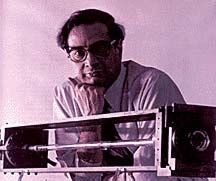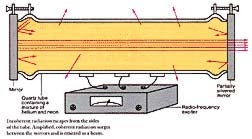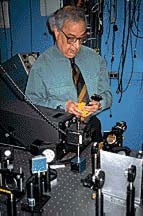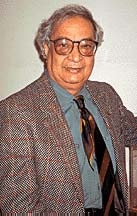|

Summer 1996 (4.2)
Pages 14-18
Scientists Who
Made A Difference
Ali Javan
The Gas Laser
and Beyond
Ali Javan with Betty Blair
  Left: Photographed in the natural purple hue of light
given off by a gas laser, Dr. Ali Javan sits behind his model
of the first Gas Laser--the Helium Neon Laser which he invented
in 1960. Photo by the late science photographer, Fritz Goro,
as it appeared in the "Smithsonian" Magazine, April
1971. Courtesy: Javan. Left: Photographed in the natural purple hue of light
given off by a gas laser, Dr. Ali Javan sits behind his model
of the first Gas Laser--the Helium Neon Laser which he invented
in 1960. Photo by the late science photographer, Fritz Goro,
as it appeared in the "Smithsonian" Magazine, April
1971. Courtesy: Javan.
Dr. Ali Javan was too busy to
meet but being the gentleman that he is, he spent nearly an hour
on the phone trying to convince me that he didn't have time for
an interview.
But Azerbaijan International was getting ready to publish an
issue devoted to the achievements of Azerbaijani scientists.
To leave Javan out would clearly be a mistake. "His place
would be missing" (as the Azeris often say). Javan, who
has lived in the United States since 1949, is of Azerbaijani
parentage. His mother and father were born in Tabriz (Iran) and
he, in Tehran.
His contribution to world science through laser technology is
widely recognized. In 1975, The Optical Society of America bestowed
upon him their most prestigious honor, the Fredric Ives Medal,
with a citation that commended him for "producing an optical
device (the Gas Laser) of unparalleled applicability to scientific
research." His Albert Einstein Award (1993) reads similarly.
In the end, I managed to persuade him. It meant he would have
to interrupt work at one of his laboratories and drive to his
office at MIT (Massachusetts Institute of Technology in Cambridge)
on a Saturday afternoon. Despite how involved he is in his research,
somehow I knew he would keep his word and so I flew 2,500 miles
across country from Los Angeles to meet him on April 13th.

Sketch depicting the principles of Dr. Ali Javan's Gas Laser.
"Smithsonian" Magazine, April 1971.
Typical of Eastern hospitality,
he first offered tea that he had prepared in one of the corners
of his stately office at MIT. In the opposite far corner of the
room was the "granddaddy" of all gas lasers-the original
invention built in 1960 which Javan fondly, and rather appropriately,
refers to as "Adam." Smithsonian Institute has their
eye on it for their Museum collection. He has promised to give
it to them-"in the future." He claims it's still in
perfect working condition. This simple-looking apparatus, about
one meter in length and now encased in glass, is one of the most
significant inventions impacting modern technology.
During the course of conversation interview, we went down to
his laboratory two floors below to a room filled with dozens
of lasers. There he demonstrated a beautiful blue (argon) laser
(like those on the cover of this magazine).
Javan is an intense person whose appearance belies his age-68.
And it's true, he's as busy now as he's ever been in his entire
life. When you're with him, you feel conscious that he's right
on the brink of a scientific breakthrough that will make a dramatic
impact on future technological development. You sense an immense
concentration of energy, determination and perseverance that
is being directed toward solving new theoretical problems that
can be put to use in everyday practical life. Javan breeds a
confidence that convinces you that, indeed, he will succeed and
that mankind will, in turn, deeply benefit.
What follows is the essence of our conversation together.
  Dr.
Ali Javan in one of his laser laboratories at Massachusetts Institute
of Technology, April 1996. Photo: Betty Blair. Dr.
Ali Javan in one of his laser laboratories at Massachusetts Institute
of Technology, April 1996. Photo: Betty Blair.
The Laser -
A Possibility in the 1930s
In the scientific world,
they always say that when the time comes for an invention or
a discovery to be made, if you don't do it, someone else will.
To a large extent, that's true. But it's not always the case.
People can miss a good idea.
When it comes to the laser-my kind of laser, the Gas Laser-I'm
convinced it could have been invented in the 1930s, not thirty
years later in 1960 when I managed to do it.
If you look back into the history of science, you find physicists-mostly
in Europe-who had come very close to the idea of lasers by 1937
and 1938. Scientists back then were studying how atoms emit light
waves and they came very close to the laser idea (light amplification
in gases by stimulated emission of radiation). From the literature
you can see that they were just about to grasp the idea but then
they moved away from it, and the idea faded. Had I been around
in the 1930s, I'm sure I would have invented the laser then.
I'm not exaggerating. I know I would have done it.
I know why these scientists missed it. They were deeply preoccupied
with the properties of matter in thermal equilibrium. In lasers,
however, atoms have to be in a non-thermal equilibrium state.
But that becomes a bit too involved for our discussion here.
Of course, these early scientists are all gone now. But, admittedly,
they were pioneers in the field.
The Laser and World
War II
We can only speculate
how the laser might have been used in World War II had such technology
existed. Laser radar, not microwave radar, might have been the
"name of the game." Today the laser has many significant
uses in defense. Back then, it's difficult to say what would
have happened, as the technology certainly would not have been
as advanced as it is today. Without a doubt, had the laser been
invented 65 years ago instead of only 35, many laser applications
would have been developed a lot sooner.
Science always develops on the strength of work done in the past.
When Newton discovered gravity, he admitted that he had "stood
on the shoulders of giants and that's how he had seen farther."
Nothing ever develops on its own, isolated from the past. There's
always a foundation for our knowledge that others have laid and
that we build upon.
The laser is a product of our knowing the nature of atoms to
perfection, specifically their wave nature. Atoms are waves and
their particle nature is the property of their own waves. We
have discovered the nature of atoms, what they are, by the light
they emit. In the 1920s, the science of the wave nature of atoms
was known down to the smallest detail. Books had already been
written on the subject. There were giants at that time who had
made these early discoveries-Neils Bohr, Schrodinger, Einstein-I
could go on naming others.
It's difficult to pinpoint the moment when a creative idea is
born. Oh, I suppose there's a beginning somewhere along the line.
But who knows? At some moment you know everything about your
invention even though you're not aware that you do. And then
suddenly it all fits together and the discovery is made.
  When I came up
with the idea for the gas laser, much of it, if not all, was
based on my intense involvement in the work I was doing. But
I knew I could make the laser work; otherwise, I wouldn't have
gone after it. When I came up
with the idea for the gas laser, much of it, if not all, was
based on my intense involvement in the work I was doing. But
I knew I could make the laser work; otherwise, I wouldn't have
gone after it.
From the very beginning people who knew of my idea were very
skeptical. Even people on my own team who were working on it
with me had hesitations and doubts. Over the years I've seen
this tendency in a lot of people. Even good physicists are sometimes
insecure in their own beliefs; they waver with uncertainty.
Once when working with one of my students on a new kind of laser,
we were ready for the final test and I jokingly said, "Hey,
what if we throw the switch and nothing happens!" Suddenly
his face turned white in panic. I laughed. "No, no, no.
It will work!" I said, trying to reassure him. And then
we flipped the switch and everything turned out right. But this
often happens with people who are deeply involved in what they
do. They're insecure and afraid even when they have no reason
to be.
Of course, sometimes there are experiments of the magnitude that
we've been talking about, where uncertainties do exist simply
because the scientific basis is not known. As a scientist, you
have to push ahead and test your ideas even if you don't know
exactly what the ultimate outcome will be. But you had better
be certain that the outcome still leads to important scientific
results.
But with something like this-the gas laser-the only thing that
mattered was to make it work. Based on my theoretical predictions,
I had to be absolutely certain that the project would succeed
before engaging a team in the engineering development phase.
At that time, I had just joined the research staff at the Bell
Telephone Laboratory (Murray Hill, New Jersey) and had managed
to convince them to give me "an open ticket" to do
whatever was necessary to test the gas laser idea.
At about the same time, two other physicists, Charles H. Townes
and Arthur L. Schawlow, had proposed a different approach to
lasers. Theirs was based on the principle of what is now known
as "Optically Pumped Lasers," which extracts laser
light from atoms by pumping them with an intense light source.
Mine was an entirely different approach. I used electric currents
(not an intense light source) to convert electrical energy into
the laser light output, a process now known as the "Gas
Laser". These two inventions-the "Optically Pumped
Laser" and the "Gas Laser" are really very different
from each other and are used for entirely different purposes.
The "Optically Pumped Laser" creates pulsating bursts
of laser light but my "Gas Laser" produces a continuous
light beam which is so pure in color that it reaches the limits
that nature permits. It was Theodore Maiman, a physicist at Hughes
Aircraft Laboratory in Malibu, California, who first succeeded
with the Townes and Schawlow laser. Maiman used a synthetic Ruby
crystal and a flash lamp to achieve the optical pumping. His
"Optically Pumped Laser" preceded my "Gas Laser"
by about six months.
The Helium - Neon
Gas Laser
For highly technical
reasons when I first tested my laser idea, I selected two inert
gases, Helium and Neon. Here's how it works. Inside the laser
apparatus, two electrodes send electric current flowing through
the gas, then a sequence of events takes place in the gas mixture.
The electrical energy is first stored as an internal energy in
an energetic state of Helium atoms, then transferred to the Neon
atoms and then converted into a laser light beam. It took me
two years and two million dollars of Bell Telephone's money to
transform that idea into a practical invention.
Incidentally, the extraction of the laser light from the laser
apparatus is done by placing two highly reflecting and parallel
mirrors at both ends of the laser apparatus. The light, which
is reflected back and forth between the two mirrors, increases
exponentially at the speed of light and builds up in intensity,
resulting in the laser light output from the laser apparatus.
I published my idea for the laser in "Physical Review Letters"
in June 1959 at a time when I was already deeply involved with
the project. I had already assembled a team and designed experiments
to measure a set of operating parameters in the gas mixture.
An important milestone took place in February and March of 1960
when our team succeeded in demonstrating the amplification of
light at the exact light wavelengths that I had predicted in
my 1959 publication. But it would take a few more months to assemble
a working laser apparatus that could extract the laser light
from the atoms.
It turns out that I had calculated the progress of our work so
carefully that I was able to forecast when we would succeed in
producing the laser light. I predicted the middle of December.
I wanted to succeed before Christmas.
And that's when it happened-right on schedule-December 12, 1960.
It was the first time in the history of science that a continuous
laser light beam had emanated from a gas laser apparatus. I remembering
looking at my watch. It was 4:20 pm. It had been snowing heavily
that day.
How do I know it was 4:20 pm? Well, it was a such momentous occasion
and I realized the impact that moment would have upon the future
of science and technology.
Today, telecommunications are among the foremost uses of the
continuous laser light beam.
The First Laser
Telephone Experiment
We knew that lasers
could be used in telecommunications back when we produced the
first gas laser beam. In fact, we tried it out the very next
day. I was living in Greenwich Village, New York City at the
time, and driving back and forth to my lab at Bell in New Jersey,
about an hour's commute. The day we succeeded in creating the
Gas Laser beam I stayed late at the Lab driving home in the wee
hours of the morning. That was usual for me. The next day when
I awoke around noon, I put in a call to the lab. One of the team
members answered and asked me to hold the line for a moment.
Then I heard a voice, somewhat quivering in transmission, telling
me that it was the laser light speaking to me. It was the voice
of Mr. Balik, now Professor at McAlaster University in Canada.
We were ecstatic-all of us. It was the first time in history
that a telephone conversation had been transmitted by a laser
beam. The date was December 13, 1960.
It turns out that members of my team together with Bell engineers
had jury-rigged what was needed to transpose the voice onto the
laser light, transmit the light beam across my lab to the far
end of the room to a light detector and then hook the voice signal
into the telephone system. Now, 35 years later, laser telecommunication
via fiber optics is commonplace because of its superiority in
transmitting high data rates, tens of thousands of times higher
than the data rate transmission by microwave which was the technology
in use back then. Laser communication is still expanding and
is the key technology used in today's "information super
highway"-the Internet.
In academics, particularly the sciences, there's a tradition
of first announcing significant breakthroughs in scientific journals
before releasing the news to the media. By Christmas, I had written
what is now considered an historical letter for the "Physical
Review Letter" (January 30, 1961) reporting our success.
The letter was co-authored with two key members of the team,
William Bennett and Don Herriott.
The day after the letter was published, a News Conference was
held at the Park Plaza Hotel in New York City. Bell Lab engineers
had set up the same voice transmission system on the Helium-Neon
Laser beam for the reporters to see and play around with. It
made the news the next morning. AT&T shares on the stock
market shot up. Back then Bell Lab provided the research arm
of AT&T. The $2 million costs of the laser project was essential
paid for by the nickels (5 cents) and dimes (10 cents) generated
from telephone calls. The invention of the gas laser has turned
out to be an incredibly far-reaching and worthwhile investment.
AT&T along with the rest of telecommunication industry is
no longer involved with research. Today, universities are doing
that job. Hundreds of gas lasers have been made to operate at
thousands of different colors in the spectrum, both in the visible
(red, green and blue), and at near ultraviolet and infrared.
All of them are based on the same principle that I established
and used in my original electric Helium-Neon laser.
A number of other important gas lasers have since evolved including
the well-known carbon dioxide gas laser (CO2 laser) which can
generate a very high-powered laser light beam, and which is used
in laser radar as well as precision metal-welding in manufacturing
for items such as pace-makers which are implanted in heart patients
to regulate their heartbeats.
The Helium-Neon Laser itself turned out to be an immensely valuable
instrument. Millions of them are being used both in research
laboratories as well as for a wide range of practical uses. One
of the most widespread uses of the Helium-Neon Gas Laser is something
many people probably take for granted in their everyday lives.
It's the scanner that reads the bar codes on shopping items at
the check-out counters in supermarkets. That red beam is a laser
light which is based on exactly the same principles as my original
laser.
In the few short years that have followed my invention, laser
research at industrial labs and universities has grown in various
directions, as has the laser industry itself. The principle of
converting electrical energy to laser light beam has been extended
to extracting the laser light from semi-conductor elements, which
is a whole new invention in itself and a huge industry as it
provides the lasers used in Compact Discs (CD's) and other applications.
More recently, the chemical energies in gases are being converted
to laser lights to produce chemical lasers. The light outputs
from a variety of gas lasers is being used as the light sources
for "optically pumped" lasers.
Academically, the field has mushroomed. At the early conferences,
there used to be only a few hundred of us participating. In April
1995 at the International Laser Conference in Baltimore on the
occasion of the 35th Anniversary of the First Gas Laser, I was
invited to speak about the early history of the field. I gave
a presentation entitled, "Gas Lasers: How Did They Come
About." Thousands attended.
As A Child
For as long as I can
remember, I've always been interested in science. I never hesitated
to get involved in science-though I'm glad my two daughters have
chosen other creative fields. It's enough to have one scientist
in the family.
As a child, I remember playing a lot with gadgets. My first attempt
to invent something was for an idea that could never have worked
out. Conceptually, it was impossible. But I tried anyway. I was
seven or eight at the time.
I finished high school in Tehran then came to the US in 1949
to finish my studies here. It was right after the war. I registered
and started taking very heavy graduate courses in physics and
math at Columbia University (New York), and later I took a lot
of courses in the humanities. I received my Ph.D. in Physics
in 1954, but stayed on four more years as a Post Doctoral student.
In the fall of 1958, I joined Bell Telephone Laboratories at
Murray Hill. Four years later, I again moved. This time from
Bell to the MIT faculty in Cambridge, Massachusetts.
New Research -
On the Verge of a Breakthrough
What's on my mind these
days? Right now, I'm doing the next thing beyond lasers. In science,
a person like me always wants to move on to the next stage of
his work-to do new things. I look back and see this as a common
denominator in all my past activities. Whenever my creative work
takes off as a field of research on its own, I always get this
urge to move on to a new area where there's a chance to make
a new impact.
I'm now working in a new area that I call "Electronics at
Optical Frequencies." Computers, for example, use microchips
that operate at radio frequencies-MHz (Mega-Hertz) and GHz (Giga-Hertz).
I'd like to take electronics out of radio frequency into the
light wave frequency range. This would speed up information processing
tremendously. The question up until now has always been, "How
can it be done?" Simply, it requires another invention.
My new work has to do with manipulating matter in a way that
has never been done before. The concept is still in the theoretical
stage. It involves the use of matter at "nano-scale".
In Physics, "nano" refers to something almost infinitesimal
in size, that is-very, very small. This work will require "nano-fabrication"
at state-of-the-art limits, the same technology used in manufacturing
computer chips.
My new approach will enable optical properties of matter in "nano-scale"
to participate in the conduction of current at light frequency
in "nano-fabricated" circuits. It's an enormous step
from where we are now. It has taken me a long, long time to arrive
at this. It's the culmination of the last 20 years of my research
in one of the segments of my work. I'm now in the process of
bringing out a major publication and hoping to put the final
touches on it sometime this summer.
From Azerbaijan International (4.2) Summer 1996
© Azerbaijan International 1996. All Rights Reserved.
Back to Index
AI 4.2 (Summer 1996)
AI Home
| Magazine
Choice
| Topics
| Store
| Contact
us
|




